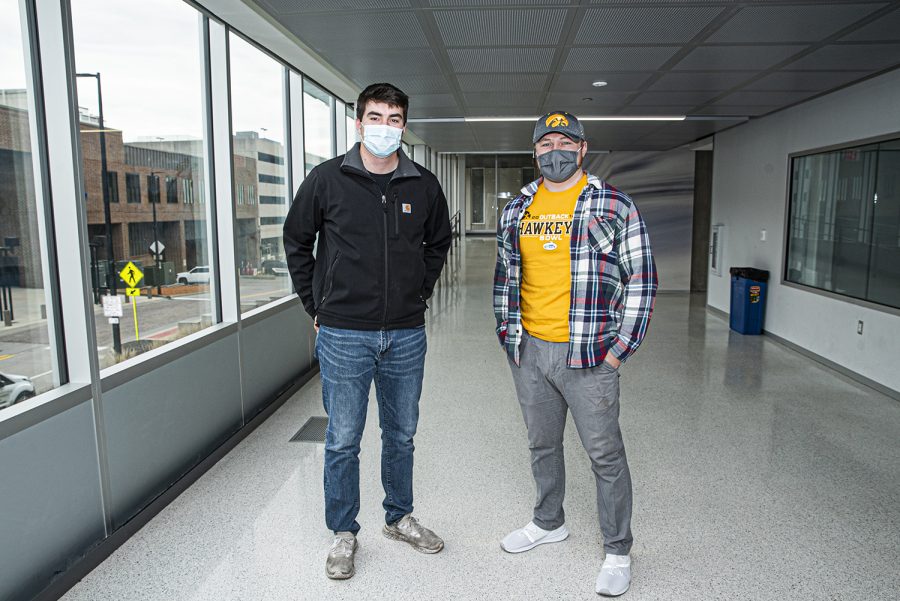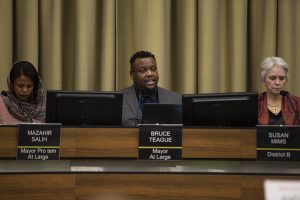University of Iowa engineering majors prepare to showcase capstone project virtually, missing networking opportunities
Four mechanical engineering students are preparing to present their project virtually this year because of COVID-19 restrictions, a change that may hamper their ability to meet with potential employers as they near graduation.
University of Iowa senior engineering students, Jake Robinson and Logan O’Brien pose for a portrait in the Seamans Center in downtown Iowa City on Wednesday, November 17th, 2020. Due to complication with COVID-19, they current class of graduating seniors will not have an in-person presentation at the end of the semester to showcase their capstone project, which is an important networking event for graduating seniors.
December 1, 2020
Logan O’Brien and a group of his friends toured the mechanical engineering projects at a showcase last year in the Main Library. As a mechanical engineering student, O’Brien knew he’d be working on a capstone project the following fall, but he didn’t know he and his groupmates would be doing it almost entirely through virtual instruction.
Almost every engineering student across the country will eventually take some form of capstone course in the latter half of their college career, where they’ll collaborate on a project that will showcase a practical use of the skills they’ve learned on the way to fulfilling their degree.
Under normal circumstances, the work students put into these projects would culminate at the end of the semester in the form of an in-person presentation to faculty and potential employers, which can be an important networking opportunity for students nearing graduation and looking for a job out of school.
Now that all classes at the University of Iowa are conducted online following fall break, the prospect of an in-person project showcase is less than practical and student-employer interaction is less of a given.
This is the situation UI mechanical engineering students Logan O’Brien and his three groupmates, Jake Robinson, Dustin Jones, and Grant Cottingham, are finding themselves in as the semester comes to a close and they wrap up work on their capstone project.
O’Brien and his groupmates designed a bow release aid – a mechanism intended to help mitigate bowhunter target panic and prevent accidental discharge of the arrow.
The group 3D printed the mechanism prototype on Nov. 21 and are preparing for their final virtual presentation to the class.
O’Brien, a senior from Channahon, Illinois, said while he thinks the UI College of Engineering has done well to supplement virtual networking opportunities this semester, he recognizes the loss that comes without the opportunity to showcase his group’s project at an in-person event.
These showcases are key for job seekers, like O’Brien, in the engineering field. Appvion Inc., a leading paper manufacturing plant located in Appleton, Wisconsin, with around 1,500 employees, offered a systems engineer position to a friend of O’Brien’s as a direct result of work she did on her senior project two years ago.
In addition to the in-person showcases, students develop professional relationships with business representatives that sponsor their capstone projects, which can act as another avenue in finding employment post graduation.
“It was a big networking opportunity,” O’Brien said of the presentation. “You’re usually talking to your sponsor, I’d say a minimum of once a week, so your sponsor gets a good idea of who you are and what you’re capable of. But other people can also say, ‘hey this is really impressive,’ reach out to you, and then you can get a job.”
O’Brien said this year was less of a known quantity, but that the college’s October virtual career fair in particular was handled well and enabled him to make connections with potential employers and industry figures.
Each group was presented with a list of about 10 project ideas, O’Brien said, which were submitted by business owners and representatives who would then become the sponsor of whichever group decided to tackle their project.
He said in addition to his group’s bow release idea, there were other options for groups to pursue ranging from developing charging stations for electric cars for the university’s Office of Sustainability to consulting projects in tandem with Iowa City’s own MODUS engineering.
“It’s definitely going to be different for sure,” O’Brien said. “I don’t think it’s going to be as big of an opportunity as in the past just because we’re on Zoom.”
One of O’Brien’s partners, Grant Cottingham, is working on the project completely virtually from his home in Ottawa, Illinois. Since the class meets online and the university provides engineering students with a virtual desktop that gives them access to the software programs they need to work on their project, Cottingham said working from out of state this semester hadn’t been a real issue for him.
RELATED: UI College of Engineering uses artificial-intelligence to solve problems across campus
O’Brien said the group also took advantage of a shared file where each member could dump information in order to communicate more easily.
Cottingham is graduating this semester and said it would have been beneficial to have the option to present his group’s work in front of industry representatives.
“It obviously is a loss,” Cottingham said. “Networking is a huge thing nowadays. I mean, connections go a long way.”
He said even though their group’s project was targeted toward bowhunters, the opportunity to showcase their work on a poster in front of representatives from all kinds of businesses could lead to on-the-spot interviews and important connections that could morph into job opportunities.
“You could be talking to someone from the energy business – a completely different industry from what our project was, yet they like how you went about your work and how you displayed it,” Cottingham said. “So yeah, that is a big loss not being able to do that in person.”
Cottingham said he was unsure how their virtual presentation to the class would go, which is slated for Dec. 10. But he’s already preparing for an upcoming interview for a job in St. Louis and exploring engineering jobs at Illinois manufacturing plants closer to home.
O’Brien and Cottingham said their group mainly relied on software such as Creo and SolidWorks that they could access through the virtual desktop, which they said they haven’t had any major issues adapting to.
The same can’t necessarily be said of some of the other departments, such as electrical engineering, where the college has needed to provide lab-grade equipment for students working remotely on their capstone projects.
Engineering Electronic Shop Systems Administrator John Kostman said one of the ways the college has adapted has been to supply students with a device called a PicoScope – a small box that connects to the student’s laptop via USB and simulates equipment students would normally interact with in a lab setting.
“You have an oscilloscope that costs $500 or a function generator that costs $300,” Kostman said. “It’s expensive to check that stuff out, so we bought PicoScopes. They’re much cheaper and do the same work.”
Kostman said he hadn’t heard of any students experiencing issues with the PicoScopes, but since the shop is only doing curbside pickups for student equipment, there’s little to no student-technician interaction.
He said the shop used to have a highly collaborative atmosphere with the college’s students that doesn’t exist in the same way after embracing the shift to working online.
“It’s challenging,” Kostman said. “The way we used to do things as a store, you talk to people face to face and you can bounce ideas back and forth. Now people don’t just walk in, they make their appointment on the phone…it’s definitely different.”
On the mechanical engineering side, he said the shop was helping a few students check out Arduino machines – programmable micro-computers that can do a variety of tasks ranging from illuminating light bulbs to controlling a robotic limb.
O’Brien said Garvin was doing well in making the course manageable despite its online nature this semester.
“I think it could be a lot – I don’t want to say worse – but different if it wasn’t for him,” O’Brien said. “It is honestly just keeping up with everything in our weekly updates and he’s really quick with questions and everything too so he’s helping a lot.”
Garvin, the university professor, said the department was working on ways to give students a networking experience as close to past years as possible, including inviting faculty and potential employers to the virtual project presentations.
He’s unsure of exactly how many potential employers would attend the virtual presentations, he said, but estimated at least a few of the companies that sponsored projects in the class would show up.
“Our department is actually going to make a flyer,” Garvin said. “We’re going to invite some people to let them know what’s going on. It’s just, you know, it’s unfortunate, but this is the hand we were dealt and we just kind of have to roll with it.”
Garvin likened the obstacle of COVID-19 in his course to other common issues engineers often need to overcome in their work.
“As an engineer, we call these things constraints,” Garvin said. “You always have to deal with constraints when you’re producing a product. The constraints could be money, resources, materials, bodies to do the work, the laws of physics…this is one of those things.”






